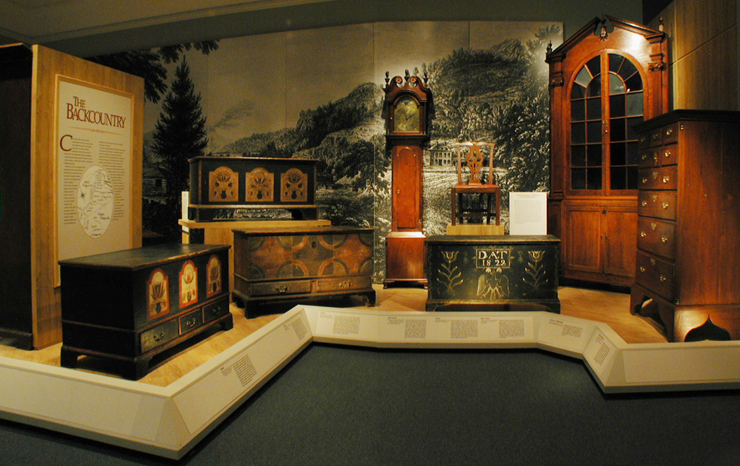

| Corner Cupboard |
| Chest of Drawers Valley or Virginia, probably Shenandoah County, 1794 Black walnut with tulip poplar and birch Catalog no. 117 |
| Chest Valley of Virginia, ca. 1800 Yellow pine with tulip poplar Gift of Donald R. Walters and Faye E. Walters |
| Side Chair Northern Valley of Virginia, probably Winchester area, 1770-1790 Black walnut The pierced splat and the serpentine crest rail with a central carved shell link this chair to Philadelphia or eastern Pennsylvania chair making traditions. So, too, does the use of seat rail tenons that extend through the rear legs, an approach rarely used by chair makers in the coastal South. Trades routes linked the Valley of Virginia directly with Philadelphia. Many artisans from that part of Pennsylvania joined the massive migration into the northern Valley of Virginia late in the colonial period. |
| The decorated chest was especially favored among residents of the southern backcountry. Chests held everything from clothes, books, and tools to medicines and foodstuffs. Chests were made of plain, inexpensive yellow pine or durable hardwoods adorned with lightwood or sulfur inlays. In German and Swiss communities, chests were often decorated with colorful and imaginative painted designs. The four chests shown here hint at the many different ornamental styles used by chest makers and decorators in the southern backcountry. |
| Chest Wythe County, Virginia, 1800-1820 Tulip poplar Gift of Mrs. Richard France |
| Chest Probably Eastern Tennessee, 1829 Tulip poplar with yellow pine |
| Chest Wythe County, Virginia, ca. 1825 Tulip poplar with yellow pine Gift of Mr. and Mrs. John M. Topham in memory of G. S. Tophaml |
German-American Influences in the Backcountry
Beginning in the 1730s, large numbers of German- and Swiss-Americans left Pennsylvania in search of land in western Maryland and Virginia. They were later joined by other groups, including many newly arrived continental European immigrants who passed through eastern Pennsylvania on their way to the Valley of Virginia. Most of them came from similar socioeconomic backgrounds and shared time-honored rural European craft traditions. The furniture made by these settlers is united by its large proportions, tendency toward durable construction, and lively sense of overall design and surface decoration.
The relative isolation of some communities in the backcountry promoted the retention of continental traditions. At the same time, German and Swiss groups experienced considerable cultural assimilation from British and northern American settlers moving down the Great Wagon Road. Such intermingling produced furniture that blended craft traditions. The five pieces displayed here reveal an awareness of British cabinetmaking practices, particularly in terms of design. However, the unmistakable stylistic and structural German character of the furniture reveals the profound cultural differences between the coastal and inland South.